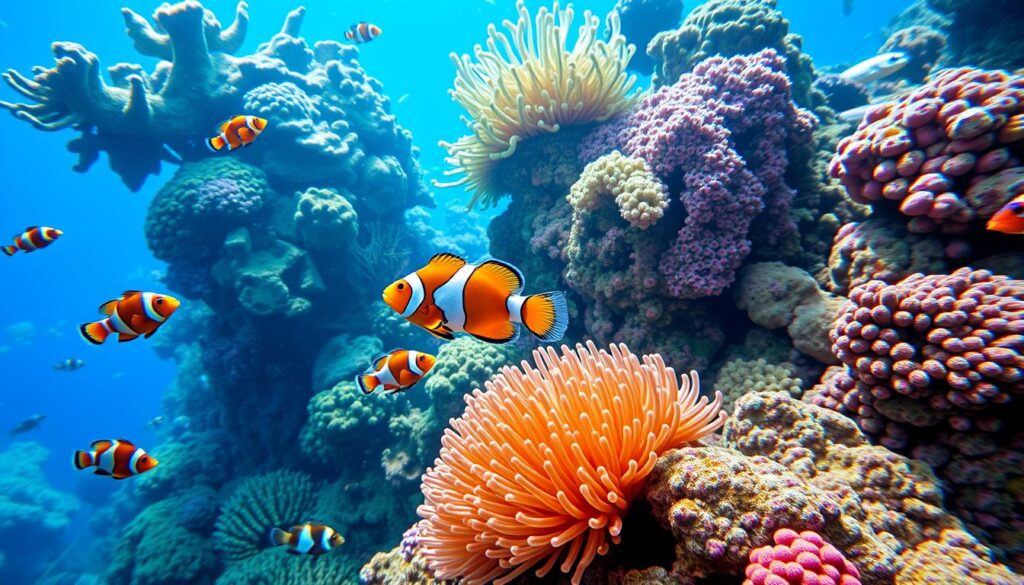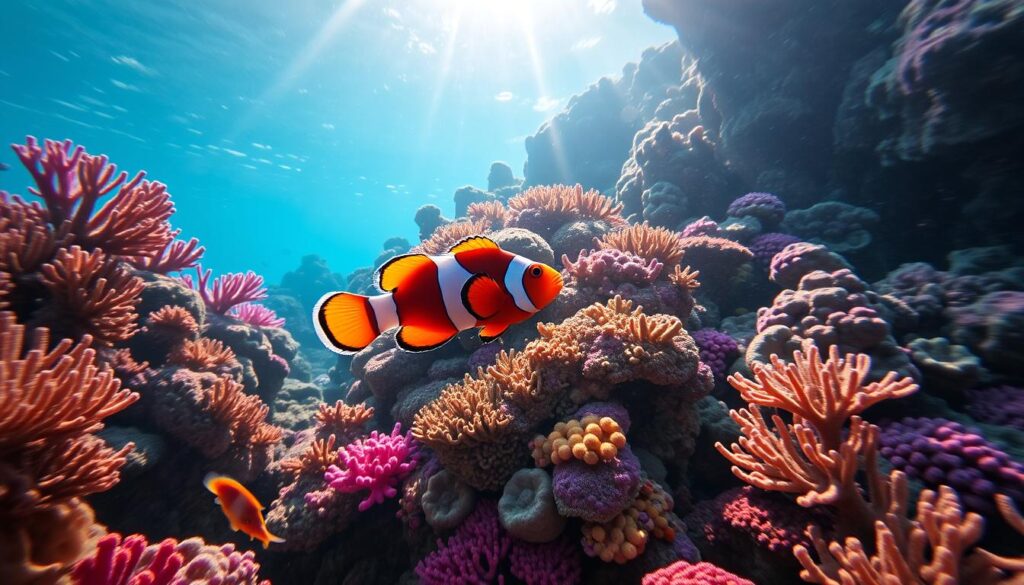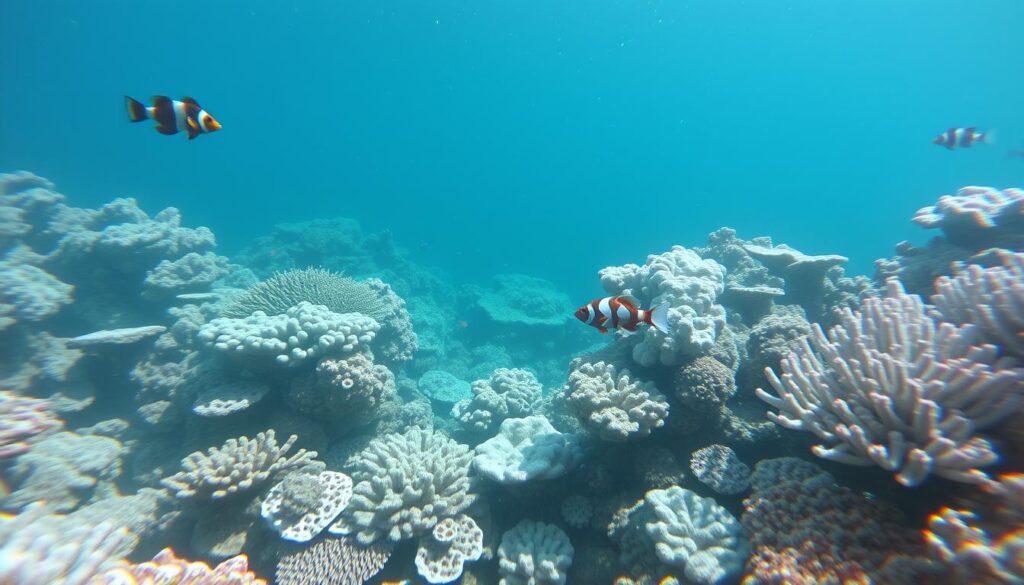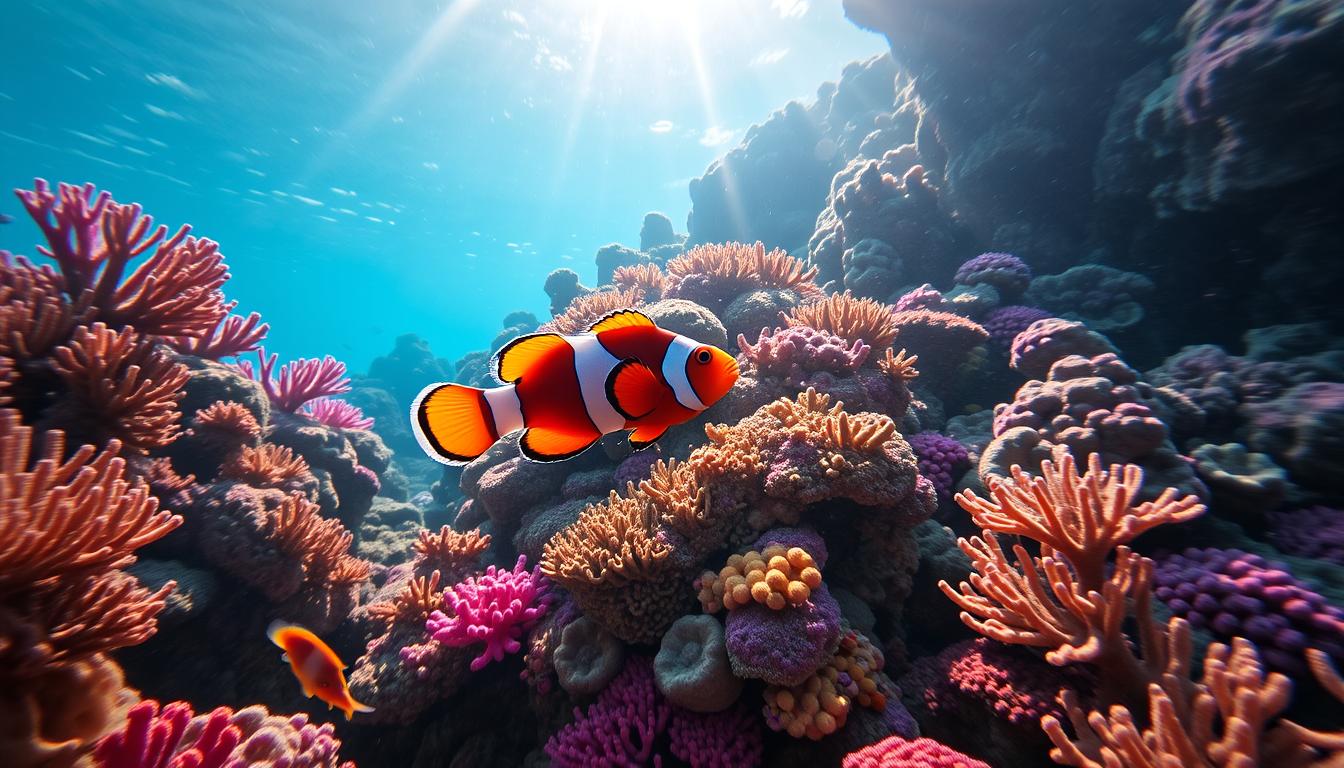
Dive into the fascinating world of clownfish, those vibrant small fish that captivate marine enthusiasts worldwide. Many people wonder: do clownfish eat coral reefs? The truth is more complex than a simple yes or no. These tiny marine creatures play a crucial role in coral reef ecosystems, with a diet that might surprise you.
Clownfish are omnivorous marine dwellers primarily found in the tropical Pacific and Indian oceans. Their diet consists of algae, zooplankton, small marine invertebrates, and crustaceans. When you explore what clownfish eat, you’ll discover they are not coral destroyers but essential participants in the reef’s delicate balance.
Understanding the clownfish diet reveals their intricate relationship with marine environments. These small fish navigate coral reefs with remarkable adaptability, consuming microorganisms and contributing to the ecosystem’s health without damaging the coral structures themselves.
Table of Contents
Understanding Clownfish: Species Overview and Habitat
Dive into the fascinating world of clownfish, vibrant marine creatures that play a crucial role in coral reef ecosystems. These small but remarkable fish have captured the imagination of marine life enthusiasts worldwide. They offer a glimpse into the intricate balance of underwater habitats.
Physical Characteristics and Distribution
Clownfish are among the most recognizable marine species. They have bright orange coloration and distinctive white-bordered black stripes. The common clownfish (Amphiprion ocellaris) is the most iconic. They grow to around 4.3 inches in length, with females slightly larger than males.
- Typical length: 4.3 inches
- Color: Bright orange with white-bordered black stripes
- Habitat: Warm waters of Indian and Pacific Oceans
Natural Habitat Requirements
Clownfish thrive in specific marine environments, especially coral reefs. These reefs provide both shelter and food sources. Their survival depends on the conditions of the ecosystem that support their unique lifestyle.
| Habitat Parameter | Optimal Conditions |
|---|---|
| Water Temperature | 75°F to 82°F (24°C to 28°C) |
| pH Level | 8.1 to 8.4 |
| Salinity | 1.020 to 1.025 specific gravity |
Common Species Varieties
The marine world boasts an impressive array of clownfish species. Amphiprion ocellaris remains the most popular. But other fascinating varieties exist, showcasing the diversity of these remarkable fish.
- Ocellaris Clownfish (most popular)
- Gold Stripe Maroon Anemonefish (up to 6 inches long)
- True Percula Anemonefish (2.8 to 3.1 inches)
“Clownfish are not just beautiful creatures, but critical components of marine ecosystems. They demonstrate the intricate connections of coral reef life.”
The Symbiotic Relationship Between Clownfish and Sea Anemones
In the vibrant coral reef ecosystem, clownfish and sea anemones share a remarkable partnership. This unique relationship is a perfect example of mutual survival. Both species benefit from each other’s presence.
The relationship between these marine organisms is more than just living together. Clownfish help sea anemones in many ways:
- Removing parasites from anemone tentacles
- Protecting anemones from predatory fish
- Delivering nutrients through their waste products
Research shows how this symbiotic interaction works. Clownfish secrete a special mucus that makes anemone tentacles safe. This lets them swim freely among deadly tentacles. In return, anemones protect them from bigger predators.
“Nature’s most ingenious partnerships often emerge from mutual necessity.” – Marine Biologist Research Team
Studies show the balance in this relationship is delicate. From 1997 to 2015, changes in clownfish and sea anemone populations were seen:
| Year | Clownfish Population | Sea Anemone Population |
|---|---|---|
| 1997 | 195 | 199 |
| 2015 | 52 | 27 |
These numbers show how fragile this marine ecosystem is. It highlights the need for conservation to protect these amazing creatures.
Do Clownfish Eat Coral Reef?
Many people are curious about clownfish and coral reefs. Let’s explore the truth about these marine wonders and their relationship with coral habitats.
Common Misconceptions About Clownfish Diet
Contrary to what many think, clownfish do not harm coral reefs. These colorful fish eat algae, zooplankton, small crustaceans, and tiny marine invertebrates. They do not consume coral structures.
- Algae
- Zooplankton
- Small crustaceans
- Tiny marine invertebrates
Impact on Coral Reef Health
Clownfish and coral reefs have a special relationship. They do not damage reefs but help keep them healthy. Their bond with sea anemones protects them and supports the marine ecosystem.
“Clownfish are not coral consumers, but integral participants in the marine ecosystem.” – Marine Biology Research Institute
Scientific Evidence and Research
Studies show that clownfish do not harm coral reefs. Their diet and relationship with sea anemones support reef health. This shows a complex interaction that benefits the ecosystem.
Clownfish even eat their own eggs if they’re unhealthy. This shows their smart survival tactics in their marine home.
Natural Feeding Habits of Clownfish
Clownfish have a fascinating diet that helps them survive in coral reefs. They eat a variety of foods, making them true omnivores. This diverse diet is key to their survival in harsh marine environments.
So, what do clownfish eat? They munch on:
- Small crustaceans
- Zooplankton
- Algae
- Fish eggs
- Larvae from various marine organisms
Wild clownfish have a unique diet. They enjoy:
- Barnacle larvae
- Tunicate larvae
- Copepods
- Algal matter
- Ctenoid fish scales
Their bond with sea anemones is vital. It offers protection and extra food.
Clownfish are skilled hunters in coral reefs. They feed near their anemone home, which gives them shelter and food. Their small size lets them explore the reef’s nooks and crannies easily.
| Food Source | Percentage in Diet | Nutritional Value |
|---|---|---|
| Zooplankton | 40% | High protein |
| Algae | 30% | Essential nutrients |
| Crustacean Larvae | 20% | Protein-rich |
| Other Marine Particles | 10% | Supplemental nutrition |
Learning about clownfish diets shows how they adapt to marine life. Their varied diet helps them survive in coral reefs.
Essential Components of a Clownfish Diet
Knowing what clownfish eat is key to their health. These colorful sea creatures have special eating habits. Their diet is a mix of what they need to eat and how they find food.
Primary Food Sources
Clownfish mainly eat small sea creatures. They feed on:
- Zooplankton
- Copepods
- Small crustaceans
- Algae
- Marine debris
Nutritional Requirements
What keeps clownfish healthy? They need a balanced diet. Experts say to feed them a variety of foods to keep them thriving.
| Food Type | Nutritional Value | Feeding Frequency |
|---|---|---|
| Frozen Seafood | High Protein | 2-3 times daily |
| Fish Pellets | Balanced Nutrients | 1-2 times daily |
| Marine Algae | Essential Minerals | Daily |
Feeding Patterns and Behavior
Clownfish hunt during the day. They eat quickly to keep their water clean. Young clownfish need to eat more often than adults.
“A well-fed clownfish is a healthy clownfish” – Marine Biologists
Feed them a portion the size of their eye each day. Understanding their diet helps keep them lively and healthy in their home.
Role of Clownfish in the Marine Ecosystem

Clownfish are key to keeping the coral reef ecosystem in balance. They are not just colorful sea creatures. They play a big role in keeping their home healthy, especially with sea anemones.
Clownfish help in many ways in the coral reef ecosystem:
- Nutrient cycling by providing nitrogen-rich waste to sea anemones
- Protecting anemone hosts from potential predators
- Cleaning parasites from their anemone partners
- Supporting biodiversity in marine habitats
“In nature, every organism has a purpose, and clownfish are no exception to this fundamental rule of ecological balance.” – Marine Ecology Research Institute
The bond between clownfish and sea anemones is amazing. About 80% of clownfish live with anemones, helping each other out. This shows how connected nature is.
| Ecosystem Contribution | Impact |
|---|---|
| Nutrient Exchange | Enhance algal tissue growth in anemones |
| Predator Protection | Defend anemone territories |
| Biodiversity Support | Maintain marine habitat balance |
Learning about clownfish helps us understand marine ecosystems better. It shows why we must protect these special relationships.
Clownfish Population Dynamics and Community Structure
Dive into the fascinating world of clownfish social dynamics. Here, marine life shows us complex community structures within coral reefs. These small but remarkable fish have a social system that challenges our understanding of animal societies.
Clownfish facts show a unique social hierarchy that makes them stand out in marine ecosystems. Their community structure is complex and adaptive. It has several key characteristics that define their social interactions:
- Groups typically consist of up to six individuals
- Social hierarchy is strictly regulated by size and gender
- All members are born male with gender-changing capabilities
Social Hierarchy Dynamics
At the heart of clownfish communities is a fascinating female-dominated social system. The largest fish becomes the female leader, and the second-largest is the breeding male. Smaller individuals are non-breeding members, creating a structured social environment.
“In the world of clownfish, size determines social status and reproductive potential.”
Breeding Patterns
Clownfish reproduction involves remarkable adaptations. When the dominant female dies, the largest male changes gender to become the new female leader. This ensures the social group and reproductive success continue.
Breeding statistics show impressive reproductive strategies:
- Can lay between 100-1,500 eggs per spawning
- Average spawning of approximately 500 eggs
- High breeding success rates reaching 80% in optimal conditions
Their commitment to marine life preservation is clear through their parental care. Males take primary responsibility for egg protection and nurturing young fish for 6-10 days after hatching.
Threats to Clownfish Survival and Conservation
The world of clownfish is facing big challenges today. Climate change is a major threat to their coral reef home. Rising temperatures and acid in the ocean make it harder for them to survive.
Key threats to clownfish survival include:
- Ocean temperature increases
- Coral bleaching events
- Habitat destruction
- Overfishing for aquarium trade
Are clownfish harmful to coral? No, they actually help the coral reef. They live with sea anemones, keeping the ocean balanced. Overfishing is a bigger threat than any harm they might cause.
“The survival of clownfish is intrinsically linked to the health of coral reefs worldwide” – Marine Conservation Research Institute
Efforts are being made to save these amazing fish. Programs breed clownfish in safe places, helping their numbers. Research and new breeding methods give us hope for their future.
About 30 clownfish species exist, but many are at risk. Saving their homes is key to keeping our oceans diverse.
The Impact of Climate Change on Clownfish Habitats
Climate change is a big threat to coral reefs and the life in them. It’s changing the balance of our oceans, affecting clownfish and their homes. This is a big problem for these underwater worlds.

- Over 75% of global coral reefs experienced bleaching-level temperatures in 2023
- Approximately 25% of marine species depend on coral reef ecosystems
- Rising ocean temperatures threaten critical marine habitats
Effects on Sea Anemone Population
Sea anemones, which live with clownfish, are seeing their numbers drop. Increased water temperatures and ocean acidification are stressing these important sea creatures.
“The future of clownfish depends on the survival of their sea anemone hosts” – Marine Biology Research Institute
Changes in Food Availability
Climate change is changing where food is found in coral reefs. Changes in ocean currents and temperature are affecting plankton. This means less food for clownfish and other sea creatures.
| Climate Change Impact | Ecosystem Consequence |
|---|---|
| Ocean Temperature Rise | Reduced Plankton Diversity |
| Coral Bleaching | Decreased Habitat Complexity |
| Acidification | Weakened Marine Food Chains |
It’s important to understand these changes to help protect our oceans. We need to find ways to save marine life and coral reefs from climate change.
Human Interaction and Conservation Efforts
Clownfish have become beloved marine creatures that captivate both scientists and aquarium enthusiasts worldwide. Their popularity has significantly impacted their natural habitats. This creates complex challenges for conservation efforts.
When exploring clownfish facts, it’s crucial to understand how human activities directly influence their survival. The aquarium trade has dramatically increased collection from wild populations. This puts substantial pressure on delicate marine ecosystems.
“Every dive operator could contribute to reef health by prioritizing sustainable practices and minimizing damaging activities.” – Marine Conservation Experts
Are clownfish harmful to coral? Quite the opposite. These small fish play a vital role in maintaining reef ecosystem balance. Their intricate relationship with sea anemones demonstrates their importance in marine biodiversity.
- Sustainable aquarium practices reduce wild population disruption
- Marine Protected Areas help preserve clownfish habitats
- Community education is crucial for conservation
- Responsible tourism supports marine ecosystem protection
Conservation strategies have emerged to protect these remarkable creatures. Organizations are developing programs that:
- Track clownfish population dynamics
- Implement breeding conservation techniques
- Educate the public about marine ecosystem preservation
Individuals can contribute by supporting sustainable marine practices. They can participate in conservation programs and raise awareness. This is crucial for the ocean ecosystems.
Scientific Research and Future Studies
Scientists are exploring clownfish and coral reefs like never before. They’re uncovering new things about these colorful worlds. This research could change how we see these ecosystems.
Researchers are looking into several important areas. These include:
- How climate change affects clownfish populations
- How marine life adapts to its environment
- The special bond between clownfish and sea anemones
New studies are uncovering amazing facts about clownfish. Steven Simpson’s research in the Northern Great Barrier Reef showed how sound helps coral larvae settle. Scientists found that playing healthy reef sounds can increase fish settlement in damaged reefs.
“Understanding marine ecosystems is key to preserving our planet’s biodiversity” – Marine Ecology Research Team
Future studies will focus on:
- Studying how reef species adapt genetically
- Creating plans to save these ecosystems
- Watching how ocean temperatures change
The SHEBA Hope Reef project is a great example of conservation work. It aims to fix over 185,000 square meters of coral reef by 2029. Projects like this give us hope for saving marine life and reefs from environmental threats.
New technologies like satellite data and genetic research are giving us new insights. They promise to reveal more about marine ecosystems in the future.
Conclusion
Clownfish and coral reefs have a complex relationship. These colorful fish don’t eat coral reefs. Instead, they help keep marine ecosystems balanced.
Their special bond with sea anemones shows how underwater habitats work together. This bond is key to the health of our oceans.
Clownfish do more than just live in coral reefs. They help the ecosystem through their eating habits and social lives. Living up to 12 years, they play a big role in the ocean’s health.
Knowing that clownfish don’t eat coral reefs is important. It helps us understand and protect them better. By learning about these fish, we can help save their homes.
Our actions can protect clownfish and their homes. We can help by supporting ocean conservation and spreading the word about their importance. This way, we can ensure these amazing fish stay healthy for years to come.
FAQ
Do clownfish actually eat coral reefs?
No, clownfish do not eat coral reefs. They mainly eat zooplankton, algae, and small crustaceans near their sea anemone homes. They help keep the coral reef ecosystem balanced, not harm it.
What is the primary diet of clownfish?
Clownfish mostly eat zooplankton, small crustaceans, algae, and parasites near their sea anemone. They are careful foragers, eating tiny organisms that come close to their home.
How do clownfish survive in sea anemones?
Clownfish have a special bond with sea anemones. They have a mucus coating that keeps them safe from the anemone’s stings. In return, they clean the anemone, give it nutrients, and protect it from predators.
Are clownfish harmful to coral reef ecosystems?
No, clownfish are not harmful. They help keep the ecosystem balanced by controlling small organism populations. They are important to the complex life of marine habitats.
How many species of clownfish exist?
About 30 species of clownfish are known, mostly in the Indo-Pacific region. Each species has its own traits and likes certain parts of coral reefs.
Do clownfish migrate or stay in one area?
Clownfish usually stay close to their sea anemone. They have a small area they call home and don’t often wander far. This keeps them safe and fed.
How are clownfish populations affected by climate change?
Climate change hurts clownfish by warming oceans, making them acidic, and damaging coral reefs. These changes can harm their relationship with sea anemones and reduce their homes, threatening their survival.
Can clownfish survive in aquariums?
Yes, clownfish can live in aquariums with the right care. They need the right water temperature, salinity, and a sea anemone or fake one. But, it’s important to care for them responsibly to protect wild populations.
How do clownfish reproduce?
Clownfish have a special way of reproducing. They can change sex. When the female dies, the top male becomes a female to keep the group going.
What threatens clownfish populations?
Many things threaten clownfish, like climate change, ocean acidification, and coral reef damage. Pollution and habitat loss also hurt them. It’s important to protect these unique fish and their homes.

